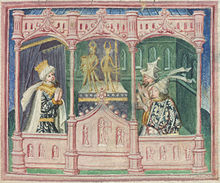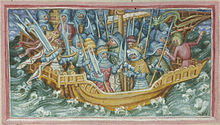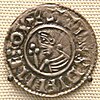Ivar the Boneless

Ivar the Boneless(Old Norse:Ívarr hinn Beinlausi[ˈiːˌwɑrːˈhinːˈbɛinˌlɔuse];diedc. 873), also known asIvar Ragnarsson,was aVikingleader who invadedEnglandandIreland.According to theTale of Ragnar Lodbrok,he was the son ofAslaugand her husbandRagnar Loðbrok,and was the brother ofBjörn Ironside,Halvdan Hvitserk,Sigurd Snake-in-the-EyeandRagnvald.However, it is not known whether or not this is historically accurate. Ivar is sometimes regarded as the same person asÍmar,a Viking king of Dublin between 870 and 873.[2]He might have been born inUppsala,Swedenin about 787.[3]
The origin of the nickname is not certain. "Ívarr beinlausi" could be translated to "Ivar legless", but "beinlausi" could also be translated as "boneless", since "bone" and "leg" are translations of the same word, "bein", inOld Norse.[4]Several of the sagas[example needed]describe him as lacking legs/bones or having a skeletal condition such asosteogenesis imperfecta,[5]while a passage inRagnarssona þáttr(also known as the tale of Ragnar's sons) suggest it refers tomale impotence.[6]
Sources
[edit]According to theTale of Ragnar Lodbrok,Ivar's bonelessness was the result of a curse. His mother, Aslaug, Ragnar's third wife was described as avölva,a seer or clairvoyant. Aslaug suggested that she and her husband wait for three nights before consummating their marriage after a long separation while he was in England raiding. However, Ragnar was passionate after such a long separation and did not heed her words. As a result, Ivar was born with weak bones.[7]
Another hypothesis is that he was actually known as "the Hated", which in Latin would beExosus.A medieval scribe with only a basic knowledge of Latin could easily have interpreted it asex(without)os(bone), thus "the Boneless",[8]although it is hard to align this theory with the direct translation of his name given in Norse sources.[7]
While the sagas describe Ivar's physical disability, they also emphasise his wisdom, cunning, and mastery of strategy and tactics in battle.[9]
He is often considered identical toÍmar,the founder of theUí Ímairdynasty, which at various times, from the mid-ninth to the tenth century, ruledNorthumbriafrom the city ofYork,and dominated the Irish Sea region as theKingdom of Dublin.[10]This would also make him the ancestor of theCrovan Dynasty.
Chronology
[edit]


- In 865 theGreat Heathen Army,led by Ivar, invaded theAnglo-SaxonHeptarchy.[11]The Heptarchy was the collective name for the seven kingdomsEast Anglia,Essex,Kent,Mercia,Northumbria,SussexandWessex.The invasion was organised by the sons of Ragnar Lothbrok, to wreak revenge againstÆlla of Northumbriawho had supposedly executed Ragnar in 865 by throwing him in a snake pit, but the historicity of this explanation is unknown.[12][13]According to the saga, Ivar did not overcome Ælla and sought reconciliation. He asked for only as much land as he could cover with an ox's hide and swore never to wage war against Ælla. Then Ivar cut the ox's hide into such fine strands that he could envelop a large fortress (in an older saga it wasYorkand according to a younger saga it was London), which he could take as his own (compare the similar legendary ploy ofDido).
- Late the next year, the army turned north and invaded Northumbria, eventually capturing Ælla atYorkin 867.[14]According to legend, Ælla was executed by Ivar and his brothers using theblood eagle,a ritual method of execution of debated historicity whereby the ribcage is opened from behind and the lungs are pulled out, forming a wing-like shape.[10]Later in the year, the army moved south and invaded the kingdom of Mercia, capturing the town ofNottingham,where they spent the winter. KingBurgred of Merciaresponded by allying with theWest SaxonkingÆthelred of Wessex,and with a combined force they laid siege to the town. The Anglo-Saxons were unable to recapture the city, but a truce was agreed whereby the Danes would withdraw to York.[14]The Great Heathen Army remained in York for over a year, gathering its strength for further assaults.[14]
- Ivar and Ubba are identified as the commanders of the Danes when they returned to East Anglia in 869, and as the executioners of the East Anglian king,Edmund the Martyr,for refusing their demand that he renounce Christ.[15]The precise account of Edmund's death is unknown, however it has been suggested that his capture and execution at the hands of the sons of Ragnar is likely to have occurred.[16]
Death
[edit]The Anglo-Saxon chroniclerÆthelweardrecords his death as 870.[17]TheAnnals of Ulsterdescribe the death of Ímar in 873. The death of Ímar is also recorded in theFragmentary Annals of Irelandunder the year 873.[18]
The identification of the king ofLaithlindasGothfraid(i.e., Ímar's father) was added by a copyist in the 17th century. In the original 11th-century manuscript, the subject of the entry was simply calledrigh Lochlann( "the king of Lochlainn" ), which more than likely referred to Ímar, whose death is not otherwise noted in theFragmentary Annals.The cause of death—a sudden and horrible disease—is not mentioned in any other source, but it raises the possibility that the true origin of Ivar's Old Norse nickname lay in the crippling effects of an unidentified disease that struck him down at the end of his life.
In 1686, a farm labourer named Thomas Walker discovered a Scandinavian burial mound atReptoninDerbyshire,close to a battle site where the Great Heathen Army overthrew theMerciankingBurgred.The number of partial skeletons surrounding the body—over 250—signified that the man buried there was of very high status. It has been suggested that such a burial mound is possibly the last resting place of Ivar.[19]
According to the saga, Ivar ordered that he be buried in a place that was exposed to attack, and prophesied that, if that was done, foes coming to the land would be met with ill-success. This prophecy held true, says the saga, until "when Vilhjalm bastard (William I of England) came ashore[,] he went [to the burial site] and broke Ivar's mound and saw that [Ivar's] body had not decayed. Then Vilhjalm had a large pyre made upon which Ivar's body was] burned... Thereupon, [Vilhjalm proceeded with the landing invasion and achieved] the victory. "[20][21]
Fictional portrayals
[edit]This sectionneeds additional citations forverification.(August 2024) |
- Ivar the Boneless is a minor character in the 1969 filmAlfred the Great,[22]portrayed as an acrobatic and agile warrior.
- In the 2013 filmHammer of the Gods,Ivar the Boneless is portrayed as a reclusive, homosexual Viking. The character was played byIvan Kaye,who later portrayed King Ælla of Northumbria in theHistorytelevision seriesVikings.[23]
- InVikings,Ivaris portrayed as the son ofRagnarand Aslaug and a younger half-brother to Björn Ironside. He first appeared in season 2 as a baby, and later was played by James Quinn Markey andAlex Høgh Andersen.[24]
- Ivar's invasion of East Anglia and killing ofEdmund the Martyrare depicted in the video forThe Darkness's songBarbarian.[25]
- Ivar is a character in the 1993 novelThe Hammer and the Cross.
- Ivar appears as a minor character inBernard Cornwell's 2004 novelThe Last Kingdom,in which his epithet "the Boneless" is explained by him being very thin. Ivar dies off-screen in the novel, and his later descendants continually appear throughout the remainder ofthe series.
- Ivar is a recurring character inUbisoft's video gameAssassin's Creed: Valhalla,which takes place in for the most part in England between 873 CE and 878 CE. He plays a significant part in the main storyline of the game.
- In the 2020 gameCrusader Kings 3byParadox Interactive,Ivar is a playable character as leader of the Jarldom of the Suðreyjar in northwestern Scotland. His character in game is missing a leg, referring to his epithet "the Boneless".
References
[edit]- ^Hervey, Francis (1907).Corolla Sancti Eadmundi = The garland of Saint Edmund, king and martyr.London: John Murray.OL11080612W.
- ^Costambeys, Marios (2004)."Ívarr [Ívarr inn Beinlausi, Ingwaer, Imhar] (d. 873)".Oxford Dictionary of National Biography.Oxford University Press.doi:10.1093/ref:odnb/49261.ISBN978-0-19-861412-8.(subscription orUK public library membershiprequired)
- ^Strittmatter, Rowena (13 December 2016).Our Ancestors: A Journey through the Generations.tredition.ISBN978-3-7323-8143-2.
- ^"Leg in Danish".dictionary.cambridge.org.Retrieved5 February2021.
- ^"Ivar the Boneless | Biography, Battles, & Facts | Britannica".9 May 2024.
- ^Groeneveld, Emma (12 November 2018)."Ivar the Boneless".World History Encyclopedia.
- ^abBaker, Mick."Anglo-Saxon Britain: In the Footsteps of Ivarr the Boneless".The History Files.Retrieved1 September2016.
- ^Ferguson, Robert (2009).The hammer and the cross: a new history of the Vikings.London: Allan Lane.ISBN978-0713997880.OCLC609990781.
- ^Mahoney, Mike."Ivar the Boneless".www.englishmonarchs.co.uk.Retrieved14 April2017.
- ^abHolman, Katherine (2007).The northern conquest: Vikings in Britain and Ireland.Oxford: Signal Books.ISBN9781904955344.OCLC166381361.
- ^Venning, Timothy (19 June 2013).The Kings & Queens of Anglo-Saxon England.Amberley.ISBN9781445608976.
- ^Munch, Peter Andreas (10 September 2010). Olsen, Magnus (ed.).Norse Mythology: Legends Of Gods And Heroes.Kessinger Publishing, LLC.ISBN9781164510307.
- ^Jones, Gwyn (1 November 1984).A History of the Vikings(Revised ed.). Oxford University Press.ISBN9780192158826.
- ^abcForte, Angelo; Oram, Richard; Pedersen, Frederik (30 May 2005).Viking Empires(First ed.). Cambridge University Press.ISBN9780521829922.
- ^Swanton, Michael J., ed. (18 August 1998).The Anglo-Saxon Chronicle(First ed.). Routledge.ISBN9780415921299.
- ^Mostert, Marco (1 January 1987).The political theology of Abbo of Fleury: A study of the ideas about society and law of the tenth-century monastic reform movement.Verloren.ISBN9789065502094.
- ^Giles, J. A., ed. (10 September 2010).Six Old English Chronicles: Ethelwerd's Chronicle, Asser's Life Of Alfred, Geoffrey Of Monmouth's British History, Gildas, Nennius And Richard Of Cirencester.Kessinger Publishing, LLC.ISBN9781163125991.
- ^"Fragmentary Annals of Ireland 409".CELT.Retrieved2 February2009.
- ^Arnold, Martin (April 2008).The Vikings: A Short History by Martin Arnold.The History Press.ISBN978-0-7524-4577-9.
- ^"Ivar the Boneless, Ragnar Lothbrok's Son - Mythologian.Net".Symbols and Their Meanings - Mythology and Gods - Mythical Creatures.28 December 2015.Retrieved19 April2017.
- ^"Saga of Ivar (The Boneless) Ragnarsson | Up Helly Aa".www.uphellyaa.org.Archived fromthe originalon 20 April 2017.Retrieved19 April2017.
- ^"Alfred the Great (1969) - Overview - TCM.com".
- ^"Hammer of the Gods".30 May 2013 – via IMDb.
- ^Schwartz, Terri (21 April 2016)."Vikings: Meet the Four New Actors Revealed in Season 4's Midseason Finale".IGN.Retrieved22 December2016.
- ^"The Darkness Return With 'Barbarian' Video: Exclusive Premiere".Billboard.com.Retrieved2 June2015.

